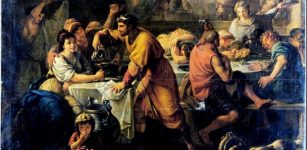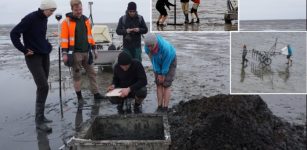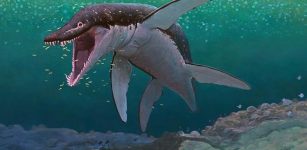Viking Longships: Fearless Dragonships Daring The Oceans And Seas
Ellen Lloyd - AncientPages.com - The Vikings were the lords of the oceans. One of the main reasons behind the Vikings' success in reaching distant lands lies in their remarkable longships. The Vikings’ ships were the European Dark Ages' greatest technical and artistic achievement. Without these great ships, the Viking Age would never have happened.
Viking warrior with a sword standing near Drakkar on the seashore. Credit: Adobe Stock - Nejron Photo
During the Viking era, there were different classes of ships. The longships were mainly used as warships, and the ships called Knarrs (or knorrs in Old Norse) served as slower passenger and cargo ships.
Viking longships were fast and could sail in shallow water. This gave the Vikings the possibility to travel up rivers as well as across the sea. In a raid, a ship could be hauled up on a beach. To surprise your enemy was an important strategic military tactic that gave the Vikings several advantages. The Vikings could jump out, start fighting, and then quickly get away if they were chased.
Many Viking ships were equipped with a dragon head on the bow. The dragon was one of the most famous symbols of the Vikings. Vikings believed the dragon could protect them against evil spirits at sea.
Vikings built their ships beside a river or an inlet of the sea. A tall oak tree was cut to make the keel. The hull of the ships was made of overlapping planks and secured with iron rivets. This made the ships very strong. A wool string was dipped in tar and forced between the planks to prevent leaks.
One man worked a big steering oar at the back end, or stern, to steer the ship.
A Viking ship with a dragon head. Credit: Adobe Stock - mastclick
Dragonships were large longships with carved heads of dragons and other magical beings mounted on their stem. They were ships for chieftains and kings. The ship’s dragonhead was a visual message about the owner’s status.
His dragon with her sails of blue,
All bright and brilliant to the view,
High hoisted on the yard arms wide,
Carries great Canute o’er the tide.
Brave is the royal progress — fast
The proud ship’s keel obeys the mast,
Dashes through foam, and gains the land,
Raising a surge on Limfjord’s strand. (The Song of Canute, Saga of St. Olaf)
"The dragonhead should scare away enemies. It also had magical functions: It would provide protection for ships and crew – and it should ward off evil spirits both on land and sea. The Icelandic law code Grágás says that the dragonhead should be taken off the ship when the Vikings returned to their homestead, not to intimidate the spirits of their native land. (Grágás was used from about 930 and written down about 1117)
The dragonhead made it easy to recognize a certain ship. It clearly shows who the leader is and where the leader is in battle. The symbolic function of the dragonhead is enhanced by the fact that ships often were named after the magical animal that graced its prow."1
A dragon ship was usually between 30-50 meters long and could carry 40 and 60 oarsmen. The men slept and ate on the deck. There was some space below the deck for stores but no cabins. Two of the most famous Viking Ships, the Gokstad Viking ship, and the Oseberg ship, were found by archaeologists in Norway.
Both ships were buried in Viking funerals between AD 800 and 900 and are now in the Viking Ship Museum in Oslo, Norway.
It was in a longship that Leif Eriksson landed on the American coast around the year 1000, long before Columbus. Of course, all other famous Viking warriors used longships when they traveled to other countries.
The longships were more or less invincible and gave the Vikings a vital advantage when they went to war or raids.
Updated on January 17, 2024
Written by – Ellen Lloyd - AncientPages.com
Copyright © AncientPages.com All rights reserved. This material may not be published, broadcast, rewritten or redistributed in whole or part without the express written permission of AncientPages.com
Expand for referencesMore From Ancient Pages
-
 Is ‘Someone’ Regularly Altering The Course Of History? – Is So How, Why And Who? Part 1
Ancient Mysteries | Nov 30, 2020
Is ‘Someone’ Regularly Altering The Course Of History? – Is So How, Why And Who? Part 1
Ancient Mysteries | Nov 30, 2020 -
 Unique Viking Age Arm Ring Found On Öland And Stunning 2,000-Year-Old Gold Torc Discovered In Trollhättan, Sweden
Archaeology | Mar 19, 2025
Unique Viking Age Arm Ring Found On Öland And Stunning 2,000-Year-Old Gold Torc Discovered In Trollhättan, Sweden
Archaeology | Mar 19, 2025 -
 Mazu: Chinese Goddess Of The Sea – Protector Of Fishermen
Chinese Mythology | Apr 16, 2016
Mazu: Chinese Goddess Of The Sea – Protector Of Fishermen
Chinese Mythology | Apr 16, 2016 -
 Saturnalia Feasts In Roman Empire
Ancient History Facts | Jun 30, 2018
Saturnalia Feasts In Roman Empire
Ancient History Facts | Jun 30, 2018 -
 Was Tutankhamun’s Chariot Equipped With Its Own Sunshade?
Archaeology | Jun 27, 2019
Was Tutankhamun’s Chariot Equipped With Its Own Sunshade?
Archaeology | Jun 27, 2019 -
 Mysterious Denny – 90,000-Year-Old Child Whose Parents Were Two Different Human Species
Featured Stories | Jul 25, 2023
Mysterious Denny – 90,000-Year-Old Child Whose Parents Were Two Different Human Species
Featured Stories | Jul 25, 2023 -
 Mystery Of The Controversial Cascajal Block – Oldest Writing In The Americas
Artifacts | Oct 12, 2017
Mystery Of The Controversial Cascajal Block – Oldest Writing In The Americas
Artifacts | Oct 12, 2017 -
 Baby God Hermes Started His Life As A Liar And Trickster
Featured Stories | Dec 25, 2020
Baby God Hermes Started His Life As A Liar And Trickster
Featured Stories | Dec 25, 2020 -
 Kingdoms Of Judah And Babylon Remained In Long-Lasting Conflict
Featured Stories | Sep 5, 2019
Kingdoms Of Judah And Babylon Remained In Long-Lasting Conflict
Featured Stories | Sep 5, 2019 -
 How Did Ancient People Wake Up On Time Before The Alarm Clock Was Invented?
Ancient History Facts | Mar 29, 2025
How Did Ancient People Wake Up On Time Before The Alarm Clock Was Invented?
Ancient History Facts | Mar 29, 2025 -
 Monte d’Accoddi – Mesopotamian Ziggurat In Europe Built By King Of Uruk?
Featured Stories | Feb 5, 2018
Monte d’Accoddi – Mesopotamian Ziggurat In Europe Built By King Of Uruk?
Featured Stories | Feb 5, 2018 -
 Akrotiri Of Thera: Sophisticated City In The Greek Cyclades Devastated By Volcanic Eruption
Civilizations | Jul 6, 2016
Akrotiri Of Thera: Sophisticated City In The Greek Cyclades Devastated By Volcanic Eruption
Civilizations | Jul 6, 2016 -
 Archaeological Evidence Of Human Presence In America 250,000 Years Ago?
Featured Stories | Mar 5, 2024
Archaeological Evidence Of Human Presence In America 250,000 Years Ago?
Featured Stories | Mar 5, 2024 -
 Lost Since 1362: Researchers Discover The Church Of Rungholt – A Sunken Medieval Trading Place
Archaeology | May 25, 2023
Lost Since 1362: Researchers Discover The Church Of Rungholt – A Sunken Medieval Trading Place
Archaeology | May 25, 2023 -
 Roman Copper-Alloy Tortoise Figurine Discovered In Suffolk, UK
Archaeology | Dec 4, 2023
Roman Copper-Alloy Tortoise Figurine Discovered In Suffolk, UK
Archaeology | Dec 4, 2023 -
 North America Is Named After An Italian Explorer
Ancient History Facts | Mar 1, 2016
North America Is Named After An Italian Explorer
Ancient History Facts | Mar 1, 2016 -
 170-Million-Year-Old Sea Monster Identified As The Oldest Mega-Predatory Pliosaur
Evolution | Oct 23, 2023
170-Million-Year-Old Sea Monster Identified As The Oldest Mega-Predatory Pliosaur
Evolution | Oct 23, 2023 -
 Ancient Cosmic Event And Unearthed Artifacts May Solve An Enduring Viking Mystery
Vikings | Dec 12, 2024
Ancient Cosmic Event And Unearthed Artifacts May Solve An Enduring Viking Mystery
Vikings | Dec 12, 2024 -
 Cisterns Unearthed In Metropolis, Turkey Give Insight Into Daily Life Of Its Inhabitants 1,500 Years Ago
Archaeology | Jan 5, 2021
Cisterns Unearthed In Metropolis, Turkey Give Insight Into Daily Life Of Its Inhabitants 1,500 Years Ago
Archaeology | Jan 5, 2021 -
 Wadjet – Egyptian Goddess Protected Pharaohs And Was Depicted As A Cobra-Uraeus
Egyptian Mythology | May 29, 2021
Wadjet – Egyptian Goddess Protected Pharaohs And Was Depicted As A Cobra-Uraeus
Egyptian Mythology | May 29, 2021



